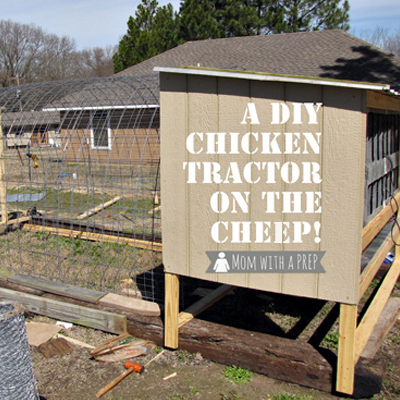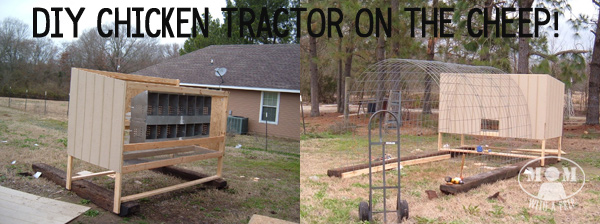

Have dreams of free ranging chickens but still want some place safe for them to be? Do you want to move them around a field or property instead of one space? A DIY Chicken Tractor might be for you! Whether you’re raising chickens in the Alaskan north to sustain yourselves, or are interested in having just a few chickens in your backyard for eggs or pets, deciding how to house them is a decision that needs to be made in the beginning.
Today’s post is very special to me. I’m writing about my Dad’s DIY chicken tractor. This is a heavy-duty tractor on his 3 acres that holds about 20 chickens while they stayed safe inside a protective run or be allowed to completely free range in the area. He can hook it up to his truck and pull it around the field to change the area to let the chickens have a fresh place to feed from and fertilize, or be protected from hot temperatures in high summer by moving them under the trees.
The total cost for his tractor was about $300. He wasn’t able to salvage all the parts, but he salvaged as much as he could, and find some real bargains along the way.


How he built his chicken tractor on the CHEEP!
- Dad used several railroad ties to create the basic ‘sled’ for the coop to ride on. On the door end, he put large eye bolts where he could hook up a chain to the pull on his truck and just drag the tractor to the next location.
- The door was a simple 2×4 frame with a hinged 2×6 framed door with chicken wire to cover.
- The actual coop was a simple frame, built on a platform and covered in siding. The platform allowed the chickens to have shade and protection beneath the coop if they needed.
- The ‘hoop’ was build with cattle wire which was heavy enough to stay formed over the simple door frame and mounted to the side of the coop house with wooden supports.
- He covered the run area with tarp during high summer to increase the shade for the chickens.
- A door was cut into the front for access to the coop, with a step rail for the chickens to gain access. A ladder was added later.
- The roof was covered in a piece of metal roof scrap.
- On the backside of the coop, he created a large hinged wall which could be opened to access the nesting boxes and clean them. (Get even more DIY nesting box ideas here)

If you look into the left back corner, you’ll see a little ladder created to access the upper floor of the nesting boxes. The floor for the coop was covered in wire to make it easier for the poo to fertilize the land and spray clean it with a hose. Here’s a similar nesting box (he made a deal with a friend to get the one here inexpensively), but you could go with something smaller. The general rule of thumb is 3-4 chickens per nesting spot.


And as you can see, even in the winter, the chickens can be outside while protected from some of the weather!

Some alternative nesting boxes you can use from salvage are:
- Wooden crates
- Plastic milk crates
- Overturned cat litter containers (put those Tidy Cat boxes to work!)
- Cat litter boxes
- Dish pans with a side cut for access

While you may not have need for a large tractor, you can take the principles of this tractor and create one that works for your backyard, just as easily!
- Downsize by using 4×4’s instead of rail road ties
- Put ties closer together. This makes a narrower footprint that you can build up the height of the tractor while adjusting the frame of the coop, itself. This is especially important if you’re taller.
- Put wheels on the backside of the tractor frame to make it more maneuverable.
- Use fewer nesting boxes for a smaller flock and create a narrower building.
Here’s the flock out free ranging. His property has a large three acre field that they have complete access to during the day, but he doesn’t always leave them out if he’s not immediately available since there are issues with predatory animals where he is.


Want some more ideas for building your own chicken coop? I’ve got 46 of them right here!
If you’d like something just a little smaller, how about a DIY version of this chicken tractor for 1 or 2.
Some Chicken Resources:
The Secret to Keeping Your Nesting Box Clean via FreshEggsDaily.com
Storye’s Guide to Raising Chickens
All You Need to Know About Nesting Boxes
Fresh Eggs Daily: Raising Happy, Healthy Chickens…Naturally by Lisa Steele
Katy Willis is a writer, lifelong homesteader, and master herbalist, master gardener, and canine nutritionist. Katy is a preparedness expert and modern homesteader practicing everyday preparedness, sustainability, and a holistic lifestyle.
She knows how important it is to be prepared for whatever life throws at you, because you just never know what's coming. And preparedness helps you give your family the best chance to thrive in any situation.
Katy is passionate about living naturally, growing food, keeping livestock, foraging, and making and using herbal remedies. Katy is an experienced herbalist and a member of the CMA (Complementary Medical Association).
Her preparedness skills go beyond just being "ready", she's ready to survive the initial disaster, and thrive afterward, too. She grows 100% organic food on roughly 15 acres and raises goats, chickens, and ducks. She also lovingly tends her orchard, where she grows many different fruit trees. And, because she likes to know exactly what she's feeding her family, she's a seasoned from-scratch cook and gluten-free baker.
Katy teaches foraging and environmental education classes, too, including self-sufficient living, modern homesteading, seed saving, and organic vegetable gardening.
Katy helps others learn forgotten skills, including basic survival skills and self-reliance.
She's been published on sites such as MSN, Angi, Home Advisor, Family Handyman, Wealth of Geeks, Readers Digest, and more.

